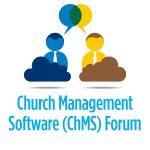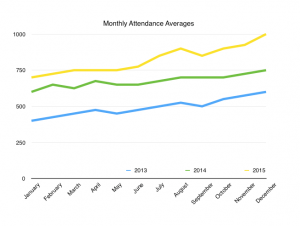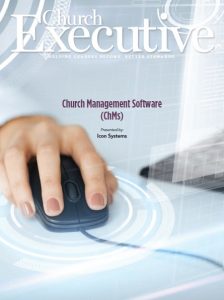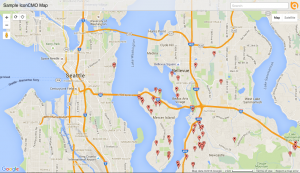By Bill Gifford
Let’s be honest: church growth isn’t about the numbers.
 It’s not about how many people attend each week, or how many people are baptized, or the size of your budget.
It’s not about how many people attend each week, or how many people are baptized, or the size of your budget.
The driving force behind why you want to expand your church has deep spiritual roots that aren’t quantifiable. But, numbers play a key role in expanding the church — and are a great tool for enabling church growth.
To get where you’re going, you have to know where you are now — and where you’d like to go. You need to create a map for planning your church expansion. This is where your church management software (ChMS) comes in.
#1: Determine whether or not your church is growing.
 Pull your general attendance numbers for the last two to three years. To make it simpler, you can lump it into monthly totals or averages. Are the numbers increasing or decreasing? By how much? Calculate the percentage.
Pull your general attendance numbers for the last two to three years. To make it simpler, you can lump it into monthly totals or averages. Are the numbers increasing or decreasing? By how much? Calculate the percentage.
Graph it so you can actually see the comparison from year to year. You’ll want to create these same graphs on a regular basis so you can track your progress over time.
#2: What kind of growth is it? Know your demographics.
If your church is indeed growing, figure out where the growth is coming from. In general, there are three different types of church growth: biological, transfer, and conversion.
Biological growth happens when existing church members have babies or adopt children. But just because a lot of babies were born this year, doesn’t mean your church is growing!
Your membership also declines when members of the church pass away, so pull the appropriate reports from your church management software. If the birth rate is higher than the death rate, then your church is experiencing biological growth.

Transfer growth happens when people leave another church for various reasons and join your church. Transfer growth can happen quickly. For example, I was recently talking to the treasurer of a church where membership doubled almost overnight when a neighboring church split.
Make sure you have a solid administrative team in place, as well as ChMS that can expand with you so you can handle a sudden influx of people.
Conversion growth is when people who are “unchurched” join your church. Typically, this is the type of growth churches focus on when they’re setting goals.
Once you understand your demographics, you can target your highest areas of growth and offerings. Here are a few different ways to accommodate the growth:
- Add worship times to your schedule
- Expand your current space, or move to a larger facility
- Plant a church or add a second location
- Offer live video streaming
#3: How do you determine which option is best? Map your members!
 Export the addresses in your database and map them so you can see where everyone lives. If the population is heavily saturated in one area, then adding worship times could be the solution. If your worship service schedule is already at capacity, then you could look at expanding your existing facilities, or having a second location where the service is streamed live.
Export the addresses in your database and map them so you can see where everyone lives. If the population is heavily saturated in one area, then adding worship times could be the solution. If your worship service schedule is already at capacity, then you could look at expanding your existing facilities, or having a second location where the service is streamed live.
If the population is more spread out, maybe it makes sense to have a second location or church plant with its own worship services.
Bill Gifford is the president of Icon Systems in Moorhead, MN. For more than 20 years, Icon Systems has been developing software that will meet the needs of any religious organization — from church plants to denominational offices.


